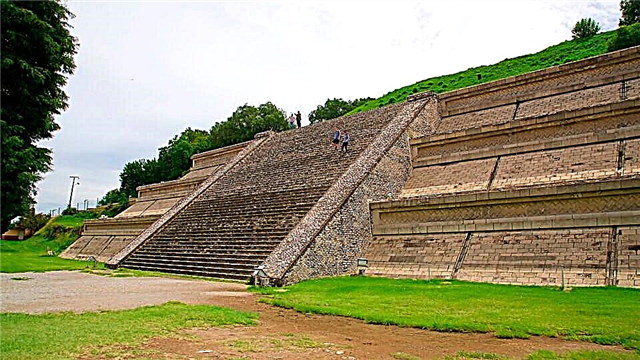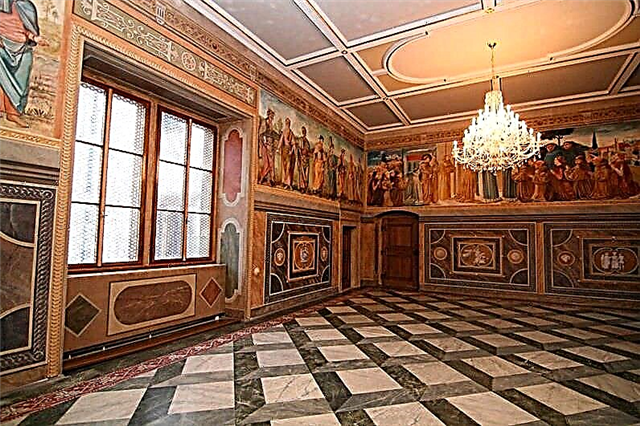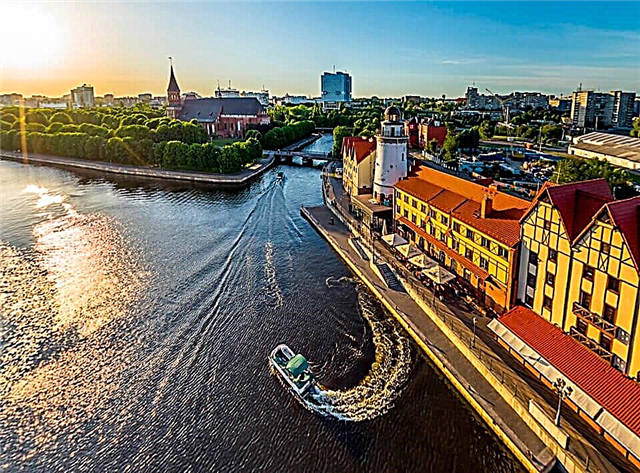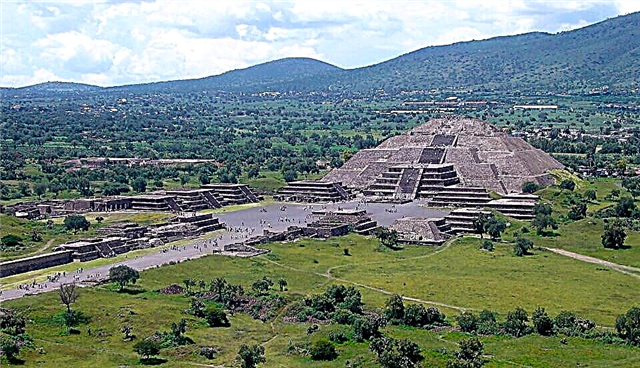The centuries-old pyramids of the Aztecs are fragments of dead civilizations that have come down to us in part in fragments. These ancient temples fascinate modern people with their grandeur, splendor and skillful design. Too many secrets are hidden behind the symmetry of silhouettes and kilometers of underground labyrinths that intricately intertwine with chains of caves that form huge halls. The powerful energy hidden in the ancient slabs makes too strong an impression.
Empire history

According to legend, the ancient Aztecs came from a place called Aztlan. Today it is impossible to say for sure whether this city existed in reality, but it was presumably located in the north. The center of their civilization was a city built on an embankment right in the center of the lake. Here, on the site of ancient Tenochtitlan, is Mexico City. The Aztec empire was constantly expanding and, despite the really high taxes that were imposed on the conquered cities, the population continued to become richer. The Aztecs paid a lot of attention to the roads, perfectly realizing how important they are for trade, which was the basis of the life of their society.
They have reached a truly high cultural and technological level of development, and also managed to preserve unique, albeit cruel, religious traditions. Their decline was rapid and fell on one of the most important periods for the history of the Western world - the time of the Great Geographical Discoveries. And just a century after the discovery of America, belligerent Spaniards appeared on its densely lush shores. It took Cortez only two campaigns to completely destroy the remains of a centuries-old civilization.
Features of the life of the Aztecs

It is customary for us to perceive the history of the Western world with its pace and peculiarities of development. We are also capable of adopting a slightly different approach to history shown by the Eastern states. But it is almost impossible to fully understand what the knowledge and the level of development of ancient civilizations were like at the moment when the West was experiencing one of its peaks. The synthesis of thousands of years of knowledge of various peoples, the inviolability of their traditions and an extremely bloody religious life came out too bizarre. The bloodlust of the Aztecs was on the verge of primitive cruelty.
Each of their many gods required a special offering. Tens of hundreds of people were killed by ripping open the poor fellows' chest. History knows cases when up to twenty thousand prisoners were sacrificed. But not only the prisoners found themselves on the altar - the local population voluntarily “went under the knife”, taking drugs for courage. Such unswerving dogmatism in matters of faith was explained by the deep conviction that only in this way it is possible to "light up" the sun. This is amazing - how could such a belief be rooted in the culture of a people who had a calendar and knew perfectly well that the cycle is continuous?
Aztec pyramids
In order for the gods to receive their offerings, the pyramids were erected - huge altars, whose steps were covered with blood. Over the entire period of its existence, the Aztec empire gave birth to hundreds of pyramids, which were erected according to the principle of "nesting dolls", when at the end of the cycle, the next layer was superimposed on one layer of the pyramid and so on ad infinitum. Unfortunately, many of them were plundered by Europeans during the period of colonization, and then covered with earth - alas, but the virtue of the invaders did not extend to the temples of the barbarians.
Pyramids of Teotihuacan

Teotihuacan is considered a "ghost town". It is located just 40 kilometers from Mexico City. This settlement is rightfully called one of the oldest - its age is estimated at more than two thousand years. During the pre-Aztec period of its history, it was the heart of the Mayan empire, but it is still not entirely clear why this civilization chose to leave the city. Today Teotihuacan has turned into a large-scale archaeological complex, but the Aztecs who once came to Teotihuacan considered it a place "where the gods touch the earth." At first, local scientists focused on excavations around the Pyramid of the Sun, whose subsequent restoration took place only at the beginning of the 20th century. The second round in the development of this complex was marked by the excavation of the Citadel - a huge arena that was located right in the center of Teotihuacan.
Its perimeter was surrounded by four walls, which were crowned with small turrets. In the center of the arena was the Temple of the Feathered Serpent, from which today only a fragment of the facade and four steps, decorated with skillful carvings, have survived. From here began the road of the Dead, which led to the pyramid of the moon. The other components of the ancient city were discovered one after another in the middle of the 20th century. Archaeologists are especially proud of two palaces, which were located slightly north of the temple buildings. It is noteworthy that the frescoes with which the ancient Aztecs decorated the walls have been preserved more than completely. Images of coyotes, eagles, snakes, jaguars, as well as some deities are still striking in their detail.
Pyramid of the moon

This pyramid is one of the oldest in Teotihuacan. Some scientists associate its name with the words "protective stone" and "mother", which are still - albeit in a modified version - found in some Indian dialects. The Pyramid of the Moon is located in the northern part of the city and resembles Cerro Gordo in its shape. Colossal for the II century AD, the structure has bilateral symmetry. This temple complex was used for animal and human sacrifices. It is possible that it was erected in honor of the goddess Chalchiuhtlicue, whose symbol was the Moon. It is with the pyramid of the moon that a lot of legends and rumors are associated. Much remains unclear.
For example, scientists still have not found a clear explanation for the fact that even after the destruction of the city, the local population continued to perform burials near the pyramid. Another mystery is associated with a burial chamber found deep in the complex. A total of 12 human remains were found, with 10 of them being carelessly dumped in the center of the room. The unfortunates were beheaded, their hands were tied behind their backs. It is possible that they were the enemies of the city, since the other two prisoners of the pyramid were seated with all reverence and adorned with jade jewelry. Perhaps they were members of the elite. Presumably they were killed during a ritual that took place during the restructuring of the pyramid of the moon.
Pyramid of the sun

Another really huge building, which is part of Teotihuacan, dates back to the pre-Aztec period of the city's existence. It is not entirely clear which civilization built this pyramid, but its dimensions are impressive. Today its base is estimated at about 900 meters, but this data is not entirely accurate. The pyramid of the Sun, which we know today, has little to do with the cult structure that people of antiquity erected. This is evidenced by many facts. For example, the presence of so-called stiffeners along the outer perimeter of the pyramid, which were supposed to strengthen the building. That's just, such architectural elements were usually located inside buildings.
In addition, different scientists at different times came to the conclusion that already at the time of the appearance in the city of the Aztecs, the pyramid had been restored more than once. Today, only traces of "coating" remain from these works, which should have slowed down the erosion of the walls.Equally interesting are the tunnels that were discovered under the pyramid. They form an extensive system and are part of a chain of underground caves. Numerous vessels, ancient mirrors and household items were discovered in the tunnels of the Pyramid of the Sun, but scientists are still not sure why these items were left here. An even bigger question, perhaps, is the too striking difference in the levels of development of civilizations - some knew how to build tunnels, others - skillfully handle clay.
Pyramid of the god Pulke in Tepoztlan

This architectural monument is located in the northern outskirts of Tepoztlan. It belongs to the El Teposteco National Park. Climbing to the pyramid is usually quite tiring - it is located at the very top of the mountain, but many tourists note that fatigue is instantly forgotten, one has only to feel the insanely strong energy of this place. There is a desire to continue the ascent in order to be in the sacred part of the pyramid. Most tourists are interested in the open side of the building, which offers an impressive view of the valley. The same part of the pyramid is the safest - there is another platform below, so death in the event of a fall is practically excluded.
The pyramid was erected in honor of the god Pulque, who, in turn, patronized the alcoholic drink of the same name and was the most generous and relatively kind deity among other bloodthirsty representatives of the Aztec pantheon. True, this did not prevent the ancient inhabitants of the pyramid from killing its builders. The point is that the reverse side of the pyramid does not seem so safe. On the contrary, it is unstable, and the slightest vibration is enough for the stones to start rolling downward. And below there are no sites - only a deep gorge, at the bottom of which poor builders were found. Analysis showed that they did not die as a result of the fall. Most likely, they were killed in advance, and then thrown off the unstable ledge.
Great Pyramid of Cholula

Cholula is one of the largest religious centers of the Aztecs. It is in this city that Tepanapa is located - the most voluminous pyramid in Mexico. This structure is truly gigantic, but its age is almost impossible to establish today. So far there are more questions than answers. For example, why was sea clay found in the pyramid's soil? Where did she come from in Cholula? And the fact that in the course of its history the pyramid more than once passed to representatives of various civilizations, who did not care too much about the original purpose of many of the construction details, does not at all facilitate archaeological research. Inside the pyramid there is a network of tunnels, whose length reaches eight kilometers.
Almost the entire pyramid is underground, and at its top is the Church of the Blessed Virgin of the Comforter. Another interesting historical episode is connected with this moment. As you know, Cortes had a habit of erecting a Catholic church on the site of every barbarian temple, but when he arrived in Cholulu and saw about four hundred temples, he had to deviate from the original plan. Now it is difficult to say whether the Spaniards knew in advance about the existence of a huge pyramid in the city, but the fact remains that the pyramid was filled up. True, it is difficult even to imagine that the Spaniards would waste time on such a laborious process and fill up the pyramid. So it happened before. But who would need to "bury" Mexico's largest pyramid?
Pyramid of the Morning Star in Tula

Tula was the oldest center of the Toltecs, a great civilization of the pre-Columbian period. Sometimes this city is identified with the semi-mythical Tollan. The main monument left to us by this civilization is the Pyramid of the Morning Star. In the course of history, it experienced destruction several times, due to which many fragments of the building were lost. So, at the top of the pyramid there was once a temple, whose vaults were supported by giant figures of the Atlanteans, but today only supports have survived from the temple and now it is absolutely impossible to establish the name of the deity in whose honor it was generally erected.
The five-meter giants survived better than other components of the pyramid, mainly due to the efforts of the priests, who at one time buried them in the ground as part of some particularly large ritual. Scientists suggest that this event may have something to do with the destruction of the temple itself.











